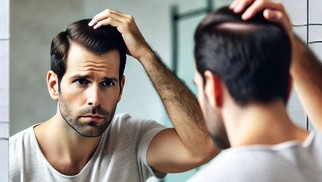Androgenic Alopecia in Men: Doctor Answers Common Questions


Androgenic alopecia, commonly known as male pattern baldness, is the most prevalent form of hair loss among men. It affects approximately 50% of men by the age of 50, with some experiencing the first signs as early as their twenties. Understanding the causes, symptoms, and treatment options is crucial for managing this condition and maintaining confidence.
What Causes Androgenic Alopecia in Males?
The primary cause of androgenic alopecia in men is genetic predisposition combined with the influence of androgens (male hormones), particularly dihydrotestosterone (DHT). DHT is a byproduct of testosterone that binds to androgen receptors in hair follicles, leading to their gradual miniaturization.
How Does It Happen?
An enzyme called 5-alpha-reductase converts testosterone into DHT, which then affects hair follicles, shortening the growth phase (anagen) and prolonging the resting phase (telogen). This leads to the thinning of hair, which eventually stops growing altogether.
Additional Factors Influencing Hair Loss:
- Genetics: If male relatives, especially on the maternal side, experienced baldness, the risk is significantly higher.
- Age: Hair loss generally progresses with age due to hormonal changes and reduced hair regeneration.
- Hormonal Imbalances: Elevated DHT levels can accelerate hair follicle miniaturization.
- Stress and Lifestyle: Chronic stress, poor diet, and lack of sleep can worsen hair loss, although they are not the direct causes of androgenic alopecia.
Androgenic Alopecia in Females
Although androgenic alopecia is more common in men, women can also experience this condition, typically manifesting as diffuse thinning over the crown and parting areas. In females, the condition is usually linked to hormonal imbalances, including elevated androgen levels during menopause or conditions like polycystic ovary syndrome (PCOS).
Key Differences Between Male and Female Patterns:
- Men typically experience receding hairlines and bald spots on the crown, whereas women see general thinning without complete baldness.
- Hormonal fluctuations, such as those caused by pregnancy, menopause, or hormonal therapies, play a more significant role in female androgenic alopecia.
Treatment Approaches for Women:
Women often respond better to topical treatments like minoxidil and oral medications that balance hormones. It is essential to consult a healthcare provider for an accurate diagnosis and tailored treatment plan.
Is Androgenetic Alopecia Reversible in Men?
Androgenic alopecia is generally a progressive and irreversible condition, as it involves the miniaturization of hair follicles over time. However, with early intervention, it is possible to slow down the process and, in some cases, partially reverse the thinning.
Possible Strategies for Managing and Slowing Hair Loss:
- Medications: Finasteride and minoxidil are the only FDA-approved medications for treating male pattern baldness.
- Lifestyle Adjustments: A balanced diet rich in essential nutrients like vitamins D, E, and B-complex, as well as minerals like zinc and iron, can support overall hair health.
- Hair Transplant Surgery: In advanced cases, hair transplantation is a viable option for restoring hair density.
The effectiveness of treatments varies depending on the individual’s age, the extent of hair loss, and genetic factors. Consulting a dermatologist or trichologist is recommended for a personalized treatment plan.
Does High Testosterone Cause Androgenic Alopecia?
A common misconception is that high testosterone directly causes hair loss. In reality, it is not the testosterone itself but its conversion into DHT that contributes to androgenic alopecia. Men with a genetic predisposition to hair loss have more sensitive hair follicles to DHT, which leads to miniaturization and eventual hair thinning.
Clarifying the Role of DHT:
- DHT binds to androgen receptors in hair follicles, causing them to shrink over time.
- The sensitivity of hair follicles to DHT is genetically determined, which is why some men with high testosterone levels do not experience hair loss.
- Blocking the conversion of testosterone to DHT with medications like finasteride can slow down or even stop the hair loss process.
It’s essential to understand that reducing testosterone levels is not a solution for androgenic alopecia, as it can lead to other health complications, including decreased libido and muscle mass. The focus should be on managing DHT levels instead.
Hair Loss at 20: Solutions for Young Men
Experiencing hair loss at the age of 20 can be emotionally challenging and impact self-esteem. In many cases, early-onset androgenic alopecia is hereditary, but other contributing factors can include hormonal imbalances, stress, poor diet, and lifestyle habits.
Effective Approaches for Young Men:
- Early Diagnosis: Early intervention can significantly slow down the progression of hair loss. It is advisable to consult a dermatologist at the first signs of thinning or receding hairlines.
- Topical Treatments: Minoxidil is a widely used topical treatment that promotes hair growth by increasing blood circulation to the hair follicles.
- Oral Medications: Finasteride is effective in reducing DHT levels, thereby slowing the progression of hair loss.
- Lifestyle Changes: Reducing stress, improving diet, and ensuring adequate sleep can support hair health and overall well-being.
Psychological Support:
Young men experiencing hair loss may face social and psychological challenges, including reduced confidence and anxiety. Seeking support from mental health professionals or joining support groups can be beneficial.
Treatment with Finpecia
Finpecia is a popular oral medication containing finasteride, which is used to treat androgenic alopecia in men. It works by inhibiting the enzyme 5-alpha-reductase, thereby reducing the conversion of testosterone into DHT.
How Finpecia Works:
- It lowers DHT levels, preventing further miniaturization of hair follicles.
- Clinical studies have shown that finasteride can slow down hair loss and, in some cases, stimulate new hair growth.
Potential Side Effects and Considerations:
- Some users may experience side effects such as decreased libido, erectile dysfunction, or mood changes.
- It is crucial to continue taking Finpecia regularly, as discontinuation can lead to a return of hair loss within several months.
- Finpecia is not recommended for women or children and should be taken under medical supervision.
Combination Therapies:
For enhanced results, Finpecia can be combined with other treatments, such as minoxidil or low-level laser therapy. Consulting a healthcare provider for a comprehensive approach is advisable.
Final Thoughts: Managing Androgenic Alopecia in Men
Androgenic alopecia is a common yet challenging condition that affects men of all ages. While it is primarily driven by genetic and hormonal factors, early diagnosis and tailored treatments can effectively slow down the progression of hair loss. From medications like Finpecia to lifestyle changes and advanced hair restoration techniques, multiple options are available for managing this condition.
For men experiencing hair loss at a young age, seeking medical advice early can help preserve hair density and boost self-confidence. Psychological support and a positive outlook are equally important in navigating the emotional aspects of androgenic alopecia.
Medically Reviewed by Dr. Faride Ramos, MD
(Updated at Feb 22 / 2025)
Finpecia Finasteride articles:
Some of the trademarks used in this Web Site appear for identification purposes only.
All orders are reviewed by a licensed physician and pharmacist before being dispensed and shipped.
The statements contained herein are not intended to diagnose, treat, cure or prevent disease. The statements are for informational purposes only and is it not meant to replace the services or recommendations of a physician or qualified health care practitioner. If you have questions about the drugs you are taking, check with your doctor, nurse, or pharmacist.

